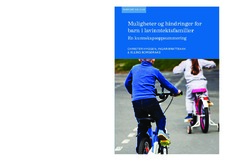| dc.contributor.author | Hyggen, Christer | |
| dc.contributor.author | Brattbakk, Ingar | |
| dc.contributor.author | Elling Borgeraas | |
| dc.date.accessioned | 2020-06-07T21:06:42Z | |
| dc.date.accessioned | 2021-04-29T14:04:59Z | |
| dc.date.available | 2020-06-07T21:06:42Z | |
| dc.date.available | 2021-04-29T14:04:59Z | |
| dc.date.issued | 2018 | |
| dc.identifier.isbn | 978-82-7894-675-6 | |
| dc.identifier.issn | 0808-5013 | |
| dc.identifier.uri | https://hdl.handle.net/20.500.12199/3499 | |
| dc.description.abstract | This report presents a scoping review of the consequences of growing up in low-income households. It has a special focus on research relevant to the Norwegian context. The review is based on a comprehensive systematic literature search using SocINDEX, ERIC, PsycINFO, Medline, Cochrane, Web of Science, Oria, SwePub and the Danish research database (DEF). The review draws particular attention to research investigating the relative importance of financial resources in itself, compared to other indicators of socioeconomic status. In addition, we have been looking for research that can say something about how the timing and exposure to low-income affects adverse outcomes. A significant number of children are growing up in low-income families in Norway, and the number is growing. Every tenth child grows up in a household with persistent low income. Low-income families with children are largely a metropolitan phenomenon. Every third child growing up in persistent low income lives in one of the country's six largest cities. In this project, relatively few studies have been identified that specifically operationalize low income or poverty. Instead, income is often included as one of several indicators of socioeconomic status, or in indicators that also contain different deprivation targets. In most cases it is difficult to unambiguously identify the effect of low income in itself. At the same time, a number of studies find that low income causes adverse outcomes for children and adolescents in the short and long term. The report identifies three general theories about possible correlation between low-income families and adverse outcomes: the investment hypothesis, family stress hypothesis and the hypothesis of the background characteristics. The report focuses on outcomes and explanations in several fields: family relationships and interaction in the family, social participation and relationships with peers, crime, education, and transition to adult roles, health, neighbourhood and housing conditions as well as intergenerational transfers of opportunities and obstacles. | en |
| dc.description.abstract | Denne rapporten presenterer en kunnskapsoppsummering om konsekvenser av oppvekst i lavinntektsfamilier, med en hovedvekt på forskning som er relevant for norske forhold. Rapporten presenterer forskning som kan sannsynliggjøre og forklare hvordan oppvekst i familier med begrensede økonomiske ressurser påvirker barn og unges livssjanser på kort og lang sikt. Forskningen omfatter forklaringer innenfor flere felt: familieforhold og samspill i familien, sosial deltagelse og relasjoner til jevnaldrende, kriminalitet, utvikling, utdanning og overgang til voksenroller, helse, helseatferd, nærmiljø og boforhold samt overføring av ulikhet fra voksne til barn. Litteratursøk. Vedlegg til NOVA Rapport 11/2018 | no_NB |
| dc.publisher | Oslo Metropolitan University - OsloMet: NOVA | |
| dc.relation.ispartofseries | NOVA Rapport 11/18 | |
| dc.subject | NOVA--Fattigdom--Youth--Children--Child welfare | |
| dc.title | Muligheter og hindringer for barn i lavinntektsfamilier. En kunnskapsoppsummering | no_NB |
| dc.type | Report | |
| fagarkivet.source.pagenumber | 224 | |
